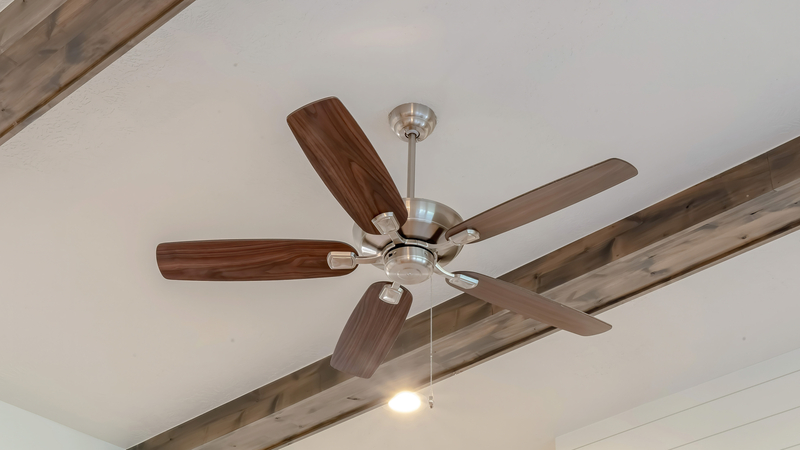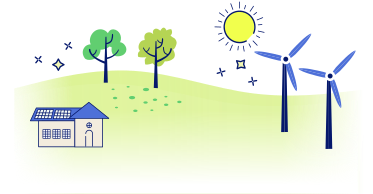This article is your guide to answering the question, “Do ceiling fans use a lot of electricity?” In general, ceiling fans don’t use that much electricity and won’t cost you too much money if you leave it running. The average ceiling fan watts is somewhere around 75 watts of electricity, but can be different depending on how big or what type of fan you have.
This guide is going to cover the different types of ceiling fans and what to expect to pay per month for average usage, so keep reading!
We hope you find this post helpful and if you are looking for different ways to become more energy efficient be sure to check out our energy savings calculator!
The Energy Professor Electricity Rate Check Tool
Do Ceiling Fans Use a Lot of Electricity?

No, ceiling fans do not use a lot of electricity. Ceiling fans are generally energy-efficient and use less electricity compared to many other appliances in your home. The amount of electricity consumed by a ceiling fan depends on various factors, including its size, speed, and efficiency, as well as the cost of electricity in your area. On average, ceiling fans consume between 10 to 120 watts of electricity, with the typical wattage ranging around 75 watts. Understanding the energy consumption of your ceiling fan can help you make informed decisions about your energy usage and reduce your electricity costs over time.
If you’re looking for ways to save on your electricity bills, understanding the wattage of your ceiling fan and how much it costs to operate can be a good starting point. In this guide, we’ll discuss the various factors and sizes that can affect the wattage of your ceiling fan and help you estimate how much electricity it uses. With the cost of electricity on the rise in the US, it’s important to be aware of how much energy your appliances and devices are consuming to make informed decisions about your energy usage and budget accordingly
What is the average wattage of a ceiling fan?
The average wattage of ceiling fans is typically around 75 watts. However, the exact wattage can vary depending on a range of factors such as the size, type, and speed of the fan. For example, larger ceiling fans may use up to 120 watts or more if operated at high speed for prolonged periods. Additionally, the energy efficiency rating of the fan, its motor, and other components can also affect its power consumption. It’s important to check the manufacturer’s specifications and consider these factors to determine the exact power usage of a ceiling fan before installation.
How many kWh does a ceiling fan use?
When it comes to calculating electricity usage, utility companies typically bill their customers in kilowatt-hours (kWh), not watts. To determine the kWh usage of your ceiling fan, you first need to convert its wattage to kilowatts (kW). For example, if the average wattage of a ceiling fan is around 75 watts, then the usage is 0.075 kW (divided by 1000 to get kW). To calculate the kWh usage, you simply multiply the kW by the number of hours the fan is used. For instance, if the fan was used for one hour, the ceiling fan kWh usage would be 0.075 kWh. This amount is less than one kWh per hour, which indicates that ceiling fans are generally energy-efficient appliances.
Related post: How Many Watts Does a Stove Use?
How Much Does it Cost to Run a Ceiling Fan?

On average, a ceiling fan typically costs around 10 cents per day to operate. For smaller ceiling fans that are 24 inches or less, the cost can be as low as 5 cents per 8 hours of use. Larger ceiling fans may cost up to 25 cents per day, depending on the frequency and duration of use. The cost of operating a ceiling fan can vary based on several factors, such as the size and efficiency of the fan, as well as the cost of electricity in your area. If you want the most accurate estimate, you’ll have to find your local electricity rate to figure out how much your fan is costing you.
How much electricity does a ceiling fan use per hour?
The wattage rating of your ceiling fan indicates the amount of power it will consume per hour. For instance, a 75-watt ceiling fan will use 75 watts of electricity each hour it runs. To measure the energy consumption of a ceiling fan per hour, we use kilowatt-hours (kWh). For example, if you have a 100-watt ceiling fan that operates continuously for 24 hours, it will consume 2400 watt-hours or 2.4 kilowatt-hours of electricity. On average, a ceiling fan consumes around 0.075 kWh or less than 1 kWh per hour of use.
How much electricity does a ceiling fan use per month?
If you’re using your ceiling fan for 8 hours a day, around 240 hours a month, you’ll be using around 18 kWh per month. To figure out the cost per month of your ceiling fan, you would take your monthly kWh and multiply that by your electricity rate. Since the national average electricity rate is around $0.15, the average ceiling fan would cost about $3 per month if running for 8 hours a day.
Related post: How Many Watts Does a Laptop Use?
Do Big Ceiling Fans Use a Lot of Electricity?

Large ceiling fans can consume significant amounts of electricity and cost up to 25 cents per day, depending on usage patterns. For instance, a large 72-inch fan may use up to 100 watts of power, which when used for 8 hours a day, would cost around $4 per month. If you require the fan to operate continuously for 24 hours a day, the cost would be significantly higher. It’s important to note that energy-efficient models with advanced features such as DC motors can help to reduce the energy consumption and costs associated with running a ceiling fan.
What are the watts for ceiling fans?
- 36-inch – 55 watts
- 42-inch – 65 watts
- 48-inch – 75 watts
- 52-inch – 88 watts
- 60-inch – 95 watts
It’s important to note that the actual power consumption may vary depending on factors such as the fan’s motor type, speed setting, and age. Additionally, if the fan has any built-in features such as lights or remote control, these may consume additional power.
How many watts is a 42-inch ceiling fan?
- A 42-inch ceiling fan will draw around 65 watts of power per hour of usage.
How many watts does a 52-inch ceiling fan use?
- A 52-inch ceiling fan will draw around 80 – 90 watts of power per hour of usage.
How many watts does a 60-inch ceiling fan use?
- A 60-inch ceiling fan can draw up to 95 watts of power per hour of usage.
Related post: How Much Watts Does a Microwave Use?
Ceiling Fan Electricity Cost FAQ

Q: How much power does an electric ceiling fan use?
A: On average, you can expect your ceiling fan to draw between 10 to 120 watts of electricity while running. While most ceiling fans use between 60 – 75 watts of electricity, depending on the size, make, and model it could be much more or less.
Q: How much does it cost to run a ceiling fan 24 hours a day?
A: If you run an average ceiling fan continuously for 24 hours, you can expect to spend around 27 cents per day to operate it. Over a month, this adds up to approximately $8 in electricity costs.
Q: Do ceiling fans increase electric bill?
A: Yes, using a ceiling fan will increase your electric bill but not by a substantial amount. The average ceiling fan only adds about $3-$4 to your electric bill per month, with only about $50 per year. With that being said, the size of your ceiling fan and how much you use it will affect how much you will be paying for your ceiling fan.
Q: Is it okay to leave ceiling fans on the time?
A: If you want to leave your ceiling fan on all the time, you will be paying a little extra in electricity costs. It will cost you at least $10 per month to run your fan for 24 hours a day if you have the average ceiling fan. If yours is larger or you run it at a higher speed, it could cost you more to run your ceiling fan all the time.
Do you Need Cheaper Electricity?
If you’ve taken the time to understand the information on your bill and discovered you’re paying more than you’d like for your electricity, have you looked around for a cheaper deal? The Energy Professor has a wealth of information on ways to save on your utilities, including details of top deals that could significantly reduce your monthly or quarterly electricity bills.
We hope you found this article helpful! If you are looking for ways to increase energy efficiency and sustainability in your home be sure to take a look at all of the latest renewable energy options in your area. The Energy Professor helps residential and small business owners find qualified energy suppliers in New York, New Jersey, Pennsylvania, Texas, Ohio, Maryland, Illinois, and Massachusetts


